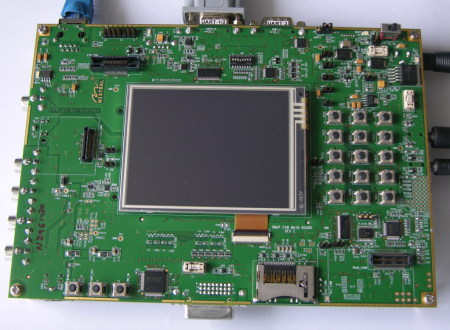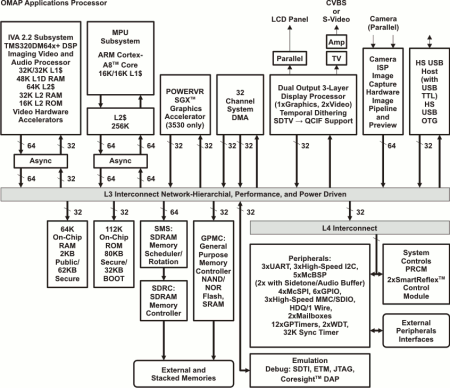OMAP3x SoC rev’d to 720MHz
Sep 29, 2009 — by Eric Brown — from the LinuxDevices Archive — 26 viewsTexas Instruments is shipping faster versions of its OMAP3530 system-on-chip (SoC) and evaluation module (EVM). The “OMAP3530 Rev E” version clocks up the ARM Cortex-A8 core from 600MHz to 720MHz,and upgrades the SoC's TMS320C64x+ DSP (digital signal processor) from 430MHz to 520MHz, says the company.
Whereas the original 600MHz OMAP3530 topped out at 1200 Dhrystone MIPS (millions of instructions per second), the 720MHz Rev E version is said to crank performance up to 1400 Dhrystone MIPS. The faster 520MHz TMS320C64x DSP, meanwhile provides "more headroom to optimize quality audio and video codecs and custom IP," says TI.
In addition to improving overall application performance, the 720MHz OMAP3530 should also support faster boot times for portable infotainment players, Point-of-Sale (POS) devices, web tablets, and single board computers (SBCs), says the company.

The Rev E version of TI's OMAP3530 EVM, sporting new video I/O
(Click to enlarge)
As before, the EVM is said to support full-featured operating systems, such as Linux and Windows Embedded CE, and it currently ships with a Linux BSP.
OMAP3530 background
The OMAP3530 is the most powerful — and appears to be the most popular — of TI's four general-purpose OMAP35xx processors, finding widespread use in consumer electronics and general embedded devices. It has also been incorporated in Digi-Key's BeagleBoard open-platform development board, as well as devices based on the $150 board.

OMAP3530 Rev E block diagram
(Click to enlarge)
The OMAP3530 shares its ARM Cortex-A8 foundation with its fellow OMAP35xx SoCs, as well as TI's somewhat similar, cellphone-oriented OMAP3430 and OMAP3440. Other SoC families based on the core include Freescale's i.MX51, and now Samsung's S5Px.
Announced in 2005, Cortex A8 is based on the ARMv7 instruction set, and offers a dual-issue, superscalar pipeline that can execute multiple instructions simultaneously. The A8 was the first ARM design to integrate the company's Neon integer and floating-point pipelines for media and signal processing. Power draw for the Cortex-A8, meanwhile, is claimed to be less than 300mW using 65nm fabrication.
Samsung recently announced its S5PC110 and S5PV210 processors, aimed at high-end smartphones and netbooks, respectively. The processors are said to be the first Cortex-A8-based SoCs to move to 45nm fabrication. Both are clocked to the Cortex-A8 limit of 1GHz, and are said to be capable of 1080p video.
Meanwhile, ARM's Cortex-A9 core, announced in Oct. 2007, should appear in finished silicon later this year or early next. The Cortex-A9 is promoted as supporting clock speeds over 1GHz and performance of around 2,000 Dhrystone MIPS. The A9 also differs from the A8 by implementing ARM's MPCore interconnect technology.
Availability
The OMAP3530 at 720MHz (Rev E) is now available in multiple package size options, The Rev E version of the OMAP3530 EVM is also said to be available. More information should be available here.
TI is continuing to sell the 600MHz version of the OMAP3530, as well as its other OMAP35xx SoCs.
This article was originally published on LinuxDevices.com and has been donated to the open source community by QuinStreet Inc. Please visit LinuxToday.com for up-to-date news and articles about Linux and open source.